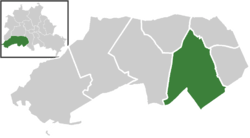Lichterfelde (Berlin)
![]()
Lichterfelde | |
|---|---|
Quarter of Berlin | |
"Emisch Haus" in Lichterfelde West | |
Location of Lichterfelde in Steglitz-Zehlendorf and Berlin  | |
 Lichterfelde  Lichterfelde | |
| Coordinates: 52°26′00″N 13°19′00″E | |
| Country | Germany |
| State | Berlin |
| City | Berlin |
| Borough | Steglitz-Zehlendorf |
| Founded | 1300 |
| Area | |
| • Total | 18.2 km2 (7.0 sq mi) |
| Elevation | 50 m (160 ft) |
| Population (2008-06-30) | |
| • Total | 78,338 |
| • Density | 4,300/km2 (11,000/sq mi) |
| Time zone | CET/CEST (UTC+1/+2) |
| Postal codes | (nr. 0602) 12203, 12205, 12207, 12209, 14167 |
| Vehicle registration | B |
History
The Prussian village Lichtervelde was founded in the 13th century by Flemish settlers. It witnessed considerable growth in the 19th century when the two "villa colonies" of Lichterfelde-West and Lichterfelde-Ost were founded: two elegant settlements for wealthy Berliners consisting completely of villas or mansions. The settlements and the historical villages of Lichterfelde and Giesensdorf were united in 1880 under the name Groß-Lichterfelde (Greater-Lichterfelde).

Lichterfelde was chosen as the seat of the Prussian Main Military academy (Hauptkadettenanstalt) in 1882, and the district became home to many famous German noble families that were linked to the Prussian Army. The world's first commercially successful electrified streetcar line, the Gross-Lichterfelde tramway, opened between the Lichterfelde-Ost railway station and the Hauptkadettenanstalt in 1881.
In 1920 Lichterfelde became part of Greater Berlin. Between 1920 and 1933, the former military academy in Lichterfelde was used by the Berlin Police. From 1933 to 1945, the grounds of the military academy were the home of the Leibstandarte SS Adolf Hitler. During this same period, the Kreisauer Kreis resistance group around Count Peter Yorck von Wartenburg and Helmuth James Graf von Moltke held its secret meetings in Wartenburg's apartment on Hortensienstraße 50, Lichterfelde-West, during the Third Reich. Generaloberst Ludwig Beck had his house on Goethestraße 24 in Lichterfelde-Ost.
From 1945 to 1994 the Hauptkadettenanstalt was used as "Andrews Barracks" by the United States Army Berlin Brigade. Today it belongs to the German Federal Archives (Bundesarchiv), headquartered in Koblenz. Two other kasernes "Roosevelt Barracks" in Gardeschützen-Kaserne (former seat of the Prussian Guards Rifles Battalion) and "McNair Barracks", a former Telefunken manufacturing plant on Goerzallee were nearby.
While Lichterfelde-Ost was in parts badly damaged during World War II, Lichterfelde-West is still largely intact and today one of the prime residential areas of Berlin. The Lichterfelde locality also houses the Berlin-Dahlem Botanical Garden and Botanical Museum and the Campus Benjamin Franklin, built in 1968 and today part of the Charité university hospital.
Sights
- Otto Lilienthal monument - the memorial plaque which is located in Schütte-Lanz-Straße 25, Berlin-Lichterfelde, was built in memory of Otto Lilienthal - a German pioneer of human aviation who became known as the Glider King. He was the first person to make successful gliding flights.
- Berlin-Dahlem Botanical Garden and Botanical Museum
- Lichterfelde Manor - historic manor house of the former village Lichterfelde
- Lichterfelde West - a villa colony from the 19th century
- Village Church Lichterfelde - Church from the 14th century
- McNair Barracks - former US Army installation in Lichterfelde, today a residential building
See also
- Berlin-Lichterfelde Ost railway station
- Lichterfelde Süd station
- Berlin-Lichterfelde West station
- Berlin Botanischer Garten station
- Osdorfer Straße station
Gallery
 Lichterfelde Manor (Gutshaus Lichterfelde)
Lichterfelde Manor (Gutshaus Lichterfelde)_KZ_Aussenlager_Lichterfelde.jpg) Memorial plaque, KZ Aussenlager Lichterfelde, Wismarer Straße 26
Memorial plaque, KZ Aussenlager Lichterfelde, Wismarer Straße 26- Telefunken Headquarters, later McNair Barracks
- Berlin-Lichterfelde West station
External links
![]()